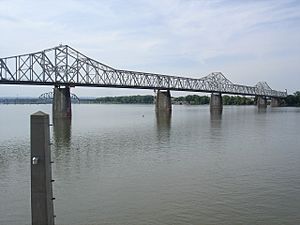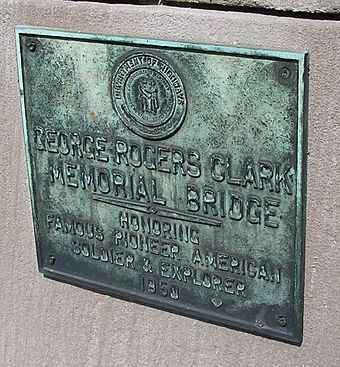George Rogers Clark Memorial Bridge facts for kids
Quick facts for kids George Rogers Clark Memorial Bridge |
|
|---|---|

The George Rogers Clark Memorial Bridge as seen from Louisville Waterfront Park
|
|
| Coordinates | 38°15′49″N 85°45′05″W / 38.26361°N 85.75139°W |
| Carries | 4 lanes of |
| Crosses | Ohio River |
| Locale | Louisville, Kentucky and Jeffersonville, Indiana |
| Other name(s) | Second Street Bridge |
| Named for | George Rogers Clark |
| Maintained by | KYTC |
| Preceded by | John F. Kennedy Memorial Bridge |
| Followed by | Fourteenth Street (L&I) Bridge |
| Characteristics | |
| Design | Cantilever bridge |
| Material | steel |
| Pier construction | granite backed by concrete |
| Total length | 5,746.5 ft (1,751.5 m) |
| Width | 38.0 ft (11.6 m) |
| Number of spans | 7 |
| Piers in water | 6 |
| Clearance below | 72.6 ft (22.1 m) at middle of channel span when river is at pool stage, or "normal" level |
| History | |
| Designer | Ralph Modjeski and Frank M. Masters |
| Constructed by | Vang Construction Company (piers) and American Bridge Company (superstructure) |
| Construction begin | June 30, 1928 (first caisson launched) |
| Construction cost | $4.8 million |
| Opened | October 31, 1929 |
|
Louisville Municipal Bridge, Pylons and Administration Building
|
|

Dedication plaque on the bridge
|
|
| Lua error in Module:Location_map at line 420: attempt to index field 'wikibase' (a nil value). | |
| Location | Spans Ohio River between Louisville, KY and Jeffersonville, IN, Louisville, Kentucky |
|---|---|
| Area | 5 acres (2.0 ha) |
| Built | 1928 |
| Architect | Multiple |
| Architectural style | Art Deco, Warren through truss |
| NRHP reference No. | 84001578 |
| Added to NRHP | March 8, 1984 |
The George Rogers Clark Memorial Bridge, also known as the Second Street Bridge, is a large bridge that crosses the Ohio River. It connects Louisville, Kentucky, with Jeffersonville, Indiana. This bridge is a type called a cantilevered truss bridge and carries four lanes of US 31.
Contents
Building the Bridge
Early Ideas and Funding
People started talking about building a highway bridge between Louisville and Jeffersonville in 1919. Everyone wanted the bridge, but they weren't sure how to pay for it. After some ideas for government funding didn't pass, officials agreed to let a private company build the bridge. This company was allowed to charge a toll (a fee to cross) to get their money back.
Design and Construction
The bridge was designed by Ralph Modjeski and Frank Masters. The beautiful architectural details were added by Paul Philippe Cret. Construction of the bridge began in June 1928. The American Bridge Company built it for about $4.7 million.
A new and clever method was used to build this bridge. Instead of building from the river banks inward, they started building from the middle of the river outwards towards the land. This new way of building worked very well. It was later used for many other bridges, including the famous Oakland Bay Bridge in San Francisco. Sadly, two workers died during the bridge's construction.
Opening and Tolls
The bridge opened to the public on October 31, 1929. It was first called the Louisville Municipal Bridge. President Herbert Hoover officially opened it. At first, the toll was 35 cents. This was lowered to 25 cents in 1936. By 1946, the company had earned back its investment, so the tolls were removed, and the bridge became free to cross.
Renaming and Improvements
On January 17, 1949, the bridge was renamed the George Rogers Clark Memorial Bridge. This honored George Rogers Clark, who is known as the founder of Louisville. The bridge was updated and repaired in 1958.
In the 1950s, there was talk of bringing back tolls because the bridge was getting very busy. More money was needed to build another bridge. However, most people living nearby did not want tolls again. Eventually, the U.S. government helped pay for two new bridges that carry interstate highways.
Famous Moments and Recognition
In a famous moment, boxing legend Muhammad Ali threw his gold medal from the 1960 Rome Olympics into the Ohio River while standing on this bridge.
The bridge was added to the National Register of Historic Places on March 8, 1984. This means it is recognized as an important historical site.
Modern Updates
In 2010, a $3 million project improved the area right under the bridge in Louisville. This area became a plaza with new lights, wide sidewalks, and places to sit. It made the space more inviting, especially for people visiting the nearby KFC Yum! Center arena.
The bridge was expected to get much busier after the Ohio River Bridges Project finished in 2016. This project changed how traffic flows on other bridges in the area. Some bridges became tolled, which made people think more cars would use the free Clark Memorial Bridge. There were some concerns about the bridge's structure, but these issues were repaired.
Bridge Culture
Local Name and Pedestrian Access
Locally, many people call it the Second Street Bridge. This is because it lines up directly with Second Street in Louisville. The bridge has sidewalks on both sides, so people can walk or bike across it. For a long time, it was the only bridge in the area where people could cross the Ohio River without a car. This changed in 2014 when the nearby Big Four Bridge also opened for walkers and bikers.
Thunder Over Louisville
Since 1991, the George Rogers Clark Memorial Bridge has been the center of the annual Thunder Over Louisville event. During the huge fireworks show, a "waterfall" of fireworks flows down the entire length of the bridge.
For this event, the bridge is closed to traffic for much of the week. Some people don't like this because it cuts off the only free way for cars and the main way for pedestrians to cross the river in downtown Louisville. This can affect local businesses and people who rely on the bridge.
In Movies
The bridge even appeared in the 1981 movie Stripes. In one scene, actor Bill Murray drives his taxi onto the bridge, gets out, and throws his keys into the river below.
Images for kids
-
Louisville Municipal (later G.R. Clark Memorial) Bridge construction progress diagram, Ohio River mile 604, Louisville, Kentucky, USA, 1928 and 1929
-
Towboat "Craig E. Philip" upbound at George Rogers Clark Memorial Bridge, Ohio River mile 604, Louisville, Kentucky, USA, September 2004, file a4i018


